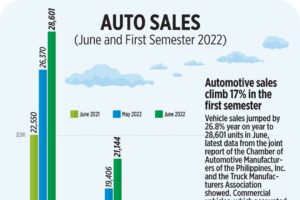Term deposit yields mixed on hawkish Fed, BSP

YIELDS on the central bank’s term deposits were mixed on Wednesday following hawkish signals from the US Federal Reserve and the Bangko Sentral ng Pilipinas (BSP).
Demand for the BSP’s term deposit facility (TDF) reached P224.66 billion on Wednesday, below the P280-billion offer but higher than the P219.989 billion in bids for the P350-billion offer at last week’s auction.
Broken down, bids for the seven-day papers amounted to P103.135 billion, lower than the P160 billion auctioned off by the BSP as well as the P109.811 billion in tenders seen in the previous week for P200 billion on the auction block.
Banks asked for yields ranging from 6.52% to 6.565%, a slightly lower band compared to the 6.5% to 6.555% seen a week ago. This caused the average rate of the one-week term deposits to inch down by 0.29 basis point (bp) to 6.5384% from 6.5413% previously.
Meanwhile, the 14-day term deposits attracted tenders amounting to P121.525 billion, above the P120-billion offer and the P110.178 billion in bids recorded a week ago for the P150-billion offering.
Accepted rates for the tenor ranged from 6.55% to 6.6%, a marginally wider margin versus the 6.56% to 6.6% seen last week. This caused the average rate of the two-week papers to inch up by 0.17 bp to 6.5824% from 6.5807% in the prior auction.
The BSP has not auctioned off 28-day term deposits for three years to give way to its weekly offering of securities with the same tenor.
The term deposits and the 28-day bills are used by the BSP to mop up excess liquidity in the financial system and to better guide market rates.
TDF yields were mixed on Wednesday amid hawkish signals from Fed officials, Rizal Commercial Banking Corp. Chief Economist Michael L. Ricafort said in a Viber message.
Top US central bank officials including Federal Reserve Chair Jerome H. Powell backed away on Tuesday from providing any guidance on when interest rates may be cut, saying instead that monetary policy needs to be restrictive for longer and further dashing investors’ hopes for meaningful reductions in borrowing costs this year, Reuters reported.
Fed policy makers have said since the start of the year that rate cuts are contingent on gaining “greater confidence” that inflation is moving towards the central bank’s 2% goal, but readings over the past few months show price pressures may even be moving in the opposite direction.
“The recent data have clearly not given us greater confidence and instead indicate that it’s likely to take longer than expected to achieve that confidence,” Mr. Powell told a forum in Washington, in what is likely to be his last public appearance before the April 30-May 1 policy meeting.
“Right now, given the strength of the labor market and progress on inflation so far, it’s appropriate to allow restrictive policy further time to work and let the data and the evolving outlook guide us,” he said.
US central bankers are universally expected to leave rates unchanged at their upcoming meeting, but until early this month analysts and investors thought rate cuts would likely start with an initial quarter-percentage-point reduction at the Fed’s June 11-12 meeting, with two more cuts happening by the end of 2024.
Now, the first cut is expected in September and the odds of a second cut are dwindling.
The Fed last month kept its target rate at the 5.25%-5.5% range for a fifth straight meeting following cumulative hikes worth 525 bps from March 2022 to July 2023.
Yields were mixed amid signals of an extended policy pause from the BSP, Mr. Ricafort added.
BSP Governor Eli M. Remolona, Jr. said on Wednesday that if “things are worse,” the start of their planned easing cycle may be pushed back to the first quarter of 2025.
He also told Bloomberg in an interview on Monday that rate cuts won’t be huge and will bring the policy rate closer to about 6%.
The Monetary Board this month left its target reverse repurchase rate unchanged at a near 17-year high of 6.5% for a fourth straight meeting.
The BSP raised borrowing costs by 450 bps from May 2022 to October 2023 to help bring down elevated inflation.
Mr. Remolona last week said upside risks to inflation have worsened, prompting the central bank to be “somewhat more hawkish than before.” — Luisa Maria Jacinta C. Jocson with Reuters




